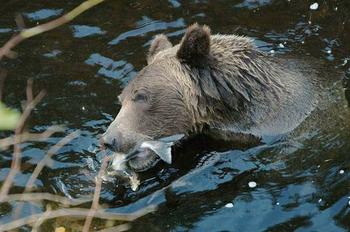Grizzly Bears Vanishing From Canada's Great Bear Rainforest
BELLA BELLA, British Columbia, Canada, September 9, 2009 (ENS) - It's called the Great Bear Rainforest, but few grizzly bears have been seen on British Columbia's north and central coast this year. Conservationists and bear viewing guides are blaming the disappearance of the bears on the overfishing of salmon, their main food source.
"I have not observed a single mother and cub-of-the-year in our traditional territory," said Douglas Neasloss, a bear viewing guide of the Kitasoo-Xaixais First Nation on the central coast. "We are extremely concerned about the status of our bears right now."
According to records kept by the federal Department of Fisheries and Oceans, DFO, the British Columbia north coast has experienced four years of extremely low chum salmon returns. Chum are the mainstay salmon species for grizzlies because they have a high fat content, last a long time in the fresh water environment and are large in size.
"DFO has once again ignored conservation concerns and permitted overfishing in Area 6 on the B.C. North Coast," said Ian McAllister of the BC-based wildlife conservation group, Pacific Wild.
 |
Grizzly bear with salmon near Knight Inlet Lodge, British Columbia (Photo by Majwick) |
"The Gil Island fishery should have ensured that more salmon passed through to spawning grounds. Instead, over six million pink salmon were intercepted by nets, in addition to tens of thousands of sockeye, chum and coho during the last openings," said McAllister. "The few bears surviving this past winter really needed those fish."
In a statement Tuesday, the conservationists, guides and First Nations urged the Department of Fisheries and Oceans and B.C. Premier Gordon Campbell to cancel the September 10 opening of the fall grizzly bear trophy hunt and close all chum salmon fisheries that affect salmon on the central and northern British Columbia coast.
To assess the cumulative damage to wildlife and habitat, they are calling for immediate government consultations with all bear viewing guides, First Nations, DFO creek walkers, Guardian Watchmen and other personnel engaged with B.C. coastal rivers
They all agree this is not an isolated incident and point to last year's unusually long, cold winter coupled with collapsed salmon stocks as the factors responsible for the disappearance of the Great Bear Rainforest's grizzly bears.
"Four years of depressed chum salmon runs have had a disproportionate impact on coastal grizzlies and their ecosystem, and are having a devastating impact on the coast," said Fred Seiler with Silvertip Ecotours based in Terrace.
In 2009, the DFO Pacific Region reports that commercial salmon fishing vessels harvested 28,779 chum salmon from April 1 through September 1 in Area 6.
In 2008, the total Area 6 gill net catch was 3,008 chum salmon compared to the 10 year average of 106,000. "This is the lowest gill net catch of chum in Area 6 since 1996," the DFO stated in its 2008 Salmon Post-Season Review document.
Seiler said, "This should be a huge red flag for DFO and the Provincial Wildlife Branch, but they continue to manage British Columbia’s salmon fishery in a total state of denial. Even as we speak they are still considering more openings when not enough fish have returned to the rivers."
This summer, B.C. Environment Minister Barry Penner expanded the no-hunting area for grizzly bears in the province, adding another 470,000 hectares (1,814 square miles), effective June 16.
The three areas closed to grizzly bear hunting are situated in the Nass-Skeena, Annuhati, and Khutze-Kitlope-Kimsquit Upper Dean-Tweedsmuir areas - all on the central and north coast.
The expansion brings the total area closed to grizzly bear hunting along this stretch of coastline to 1.9 million hectares (7,335 square miles).
In a July 6 statement Penner said, "Hunting of bears is only permitted in areas where bear populations can sustain a controlled harvest and where bear populations are determined to be either stable or increasing."
 |
One of about 50 grizzly bears in the Khutzeymateen Grizzly Bear Sanctuary on the north coast, Canada's only grizzly bear sanctuary (Photo by Dy) |
"According to the best available science, sustainable harvest rates for grizzly bears can be as high as nine percent where hunting is permitted. The Ministry of Environment manages the grizzly bear harvest rate in B.C. more conservatively at a maximum of six percent for total human-caused mortality, with an actual harvest rate of approximately two to four percent in many grizzly bear population units where hunting is permitted."
The B.C. government has worked with First Nations on the coast to implement land-use decisions agreed to in 2006 and 2007, Penner said, adding that the establishment of three additional closed areas for grizzly bears resulted from "extensive public and First Nations dialogue over many years."
The no hunting areas for grizzlies were originally conceived as part of the Grizzly Bear Conservation Strategy and endorsed by the Grizzly Bear Scientific Panel in 2002. Specific locations were agreed to through the land-use planning table, stakeholder feedback and government-to-government discussions with First Nations.
In an October 2008 grizzly bear population estimate, Ministry of Environment biologist Tony Hamilton revised his 2004 estimate of 16,887 grizzlies down to 16,014 - a loss of 873 bears.
But says Hamilton, "These changes have resulted from refinements to the population model. The new estimate does not reflect a decline in the provincial grizzly bear population."
Those assurances do nothing to satisfy the concerns of the north coast conservationists and bear viewing guides.
McAllister warns, "The apparent loss of so many bears should be an immediate and priority concern for both levels of government. The collapse of the Fraser sockeye and now the north coast chum salmon is leading to ecological collapse of our coastal ecosystem - and no species is feeling this threat more than our coastal grizzly bears."
Copyright Environment News Service (ENS) 2009. All rights reserved.
To subscribe or visit go to: http://www.ens-newswire.com